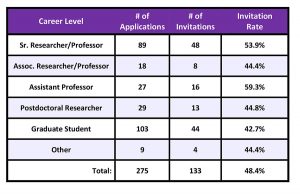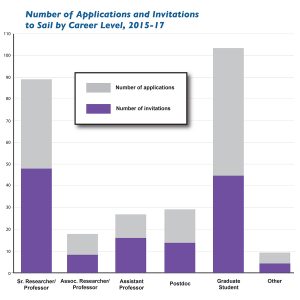Thoughts and Advice on Applying to Sail
When Lamont-Doherty assumed management of the U.S. Science Support Program (USSSP) in early 2015, one of our main goals was to make the IODP expedition staffing process as transparent as possible. As we approach our fourth year of management, we would like to provide some statistics on U.S. shipboard participation in IODP over the past three years, as well as advice for those aspiring to sail.
The process of shipboard staffing is explained on the “Apply to Sail” page of the USSSP website (https://usoceandiscovery.org/expeditions/). It begins when one of the three ship operators—the JOIDES Resolution Science Operator (JRSO); the ECORD Science Operator (ESO, the operator of mission-specific platforms); or Japan’s Center for Deep Earth Exploration (CDEX, the operator of Chikyu)—issues a Call for Applications. Candidates from each IODP nation or consortium apply to their individual Program Member Office (PMO); those in the U.S. apply to USSSP. U.S. applications are reviewed by the Staffing Subcommittee of the U.S. Advisory Committee for Scientific Ocean Drilling (USAC), currently chaired by Marta Torres, which weighs a number of factors in its evaluations, including the expertise needed to achieve the expedition’s scientific objectives, the strength of each applicant’s proposed postcruise research plan, and the importance of ensuring diversity of career level, institution, and gender in the U.S. science party. After considerable consultation with USAC, USSSP assembles and reviews the rankings and comments and forwards them to the relevant operator. Finally, the operator works with the expedition co-chiefs and expedition project manager to balance expertise, national quotas, and diversity before issuing invitations to sail. Invitations are sometimes issued iteratively—that is, some are issued later and are conditional upon the responses to previous ones. The overall process is represented graphically here.
This is a complex process, with a lot of moving parts that can seem opaque to applicants. At various times it has been suggested that either USAC, the operators, or the co-chiefs may have a disproportionate influence on the selection process. In truth, the process is collaborative and works remarkably well, with excellent communication amongst all of the parties involved. This is a tribute to all three operators, which are extraordinarily cooperative with USSSP and which labor to assemble the best possible science party to address expedition objectives while also providing the proper mix of senior and early career scientists, including students. This allows younger participants to benefit from mentoring by senior scientists, while also assuring the development of the next generation of IODP leaders.
USSSP and USAC feel strongly that a successful shipboard staffing program must provide opportunities for U.S. scientists at all career levels. To this end, our office has tracked in detail both the number of applications received from, and the number of invitations issued to, U.S. applicants at all career levels since we assumed management of USSSP. Graduate students comprise the largest percentage of the overall applicant pool (over 37% of all applications). Next are senior researchers/professors (about 32%), followed by postdocs (11%), assistant professors (10%) and associate researchers/professors (7%). A few scientists fall outside of these categories (e.g., emeritus researchers) and make up the remainder of the applicants.

As indicated in the table and figure below, assistant professors are invited at the highest rate (59%), though their overall numbers are small, while senior researchers are invited at a rate of about
54%. “Early career“ researchers (defined as assistant professors and postdocs) are invited at a rate of slightly over 50%, indicating that this population, despite many challenges that may suppress applicant numbers (e.g., teaching obligations, uncertainty about future academic affiliation, and the need to prepare for the tenure process), is being afforded career-building opportunities to sail. Finally, graduate students are invited to sail at a very respectable rate of almost 43%, and have comprised over 30% of all U.S. science party berths filled during our management period. The takeaway message here is that scientists at all career levels, including graduate students, have a very reasonable chance of sailing, provided they submit competitive, high-quality applications.
Excluding co-chief scientists, who are not reviewed by USAC, the gender balance of all U.S. science parties staffed on our watch has been 56% male and 44% female. This compares very favorably to the longer-term balance over the life of IODP, which is closer to 2:1 male. (Interestingly, the aggregate U.S applicant pool also
 breaks out as 56% male and 44% female, indicating an identical acceptance rate.)
breaks out as 56% male and 44% female, indicating an identical acceptance rate.)
What makes an application to sail competitive? First, your participation plan should address how you will contribute to specific expedition objectives. Make sure you read the expedition summary on the operator’s expedition web page; you may also wish to read the IODP proposal(s) on which the expedition is based. Your participation plan should be clear, focused, written for a non-specialist Earth Science audience, and have goals that are achievable within the one year moratorium. Avoid dwelling on past accomplishments; these can be gleaned from your CV.
Second, graduate students and postdocs should provide as much information as possible concerning their likely affiliation at the time of the expedition and during the expedition moratoriumperiod. It is important to demonstrate that you will have access to a laboratory for your proposed postcruise research, as well as an institutional affiliation through which your salary and postcruise support can be routed. We recognize these may be
uncertain at the time you apply, but let us know the paths you are pursuing. Graduate students are encouraged to ask their advisors to include such information in their letters of recommendation.
Finally, applicants should take advantage of expedition webinars, usually held around two weeks before the application deadline. These are an invaluable source of expedition-specific information, and will also allow you to engage directly with at least one co-chief scientist and the expedition project manager, as well as with USSSP personnel. Both the expedition objectives and application process are addressed in detail during these webinars, which are announced in the USSSP Community Update emails and on the expedition-related pages on the USSSP website. If you are unable to attend a webinar, you can watch a recording of it after the fact. The webinars are well worth your time, especially for younger applicants and those less familiar with the program.
Sailing on an IODP expedition can be a life-changing experience. If you are considering applying to sail, I hope you find the information in this letter both illuminating and encouraging. Please feel free to contact a USAC member or USSSP if you have remaining questions about the staffing process.
Good luck!
Carl Brenner
Director, U.S. Science Support Program, IODP






